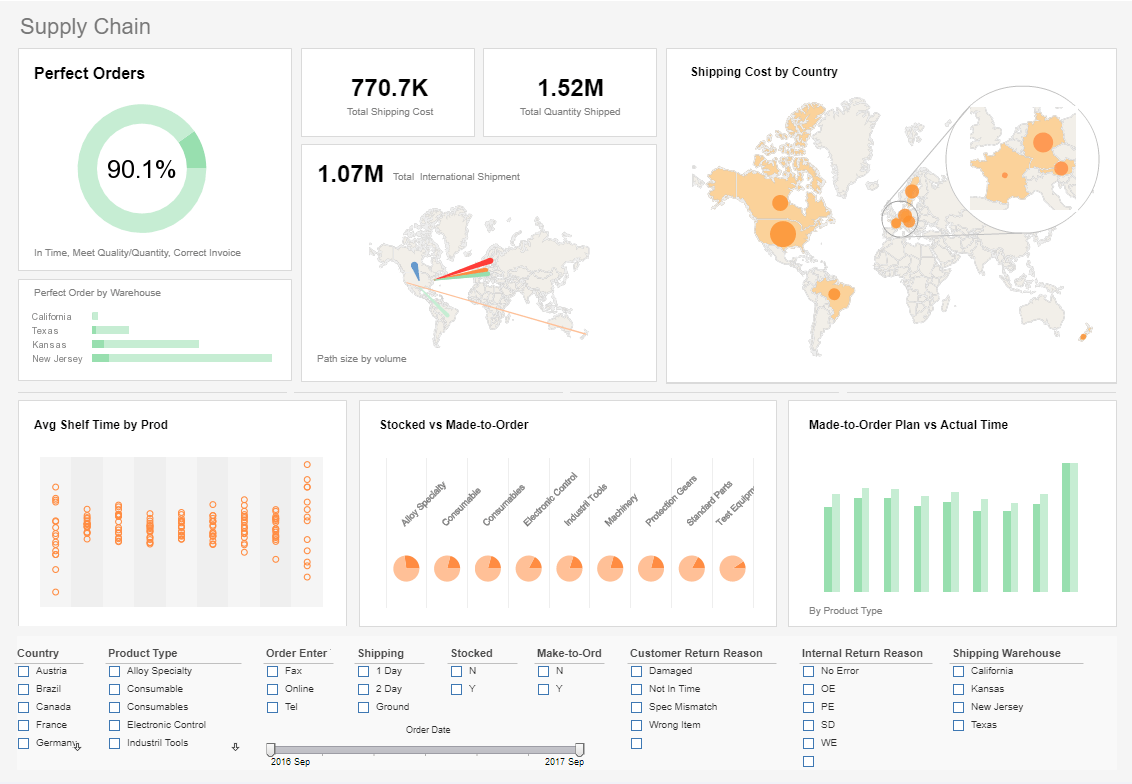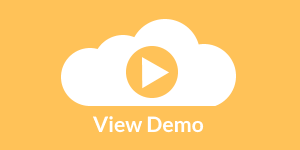Examples of Geographic Business Intelligence
This is a continuation of the transcript of a Webinar hosted by InetSoft entitled "Geographic Business Intelligence." The speaker is Mark Flaherty, CMO at InetSoft.
Mark Flaherty (MF): So now let’s talk about a few examples. First, let’s think about what a purely GIS example looks like. Take a forestry agency, for instance. They use GIS for a number of cases, including reporting to various stakeholders. So when they choose to plant or sell areas of the forest, they need to inform a number of other environmental bodies, other government departments, as well as the general public.
So before they had this system they would take digital photographs of the landscape and doctor them in certain ways to show what the landscape model might look like after the planned changes. So naturally that’s a manual, albeit artistic process, that is done in one-off use-cases.
With GIS, the process is much more efficient, and the communication can be more effective. The image is now generated from the actual organizational data. So in a way, this is already a form of business intelligence report.
Take another example from the same organization. In this case, we’re talking about 2D mapping. They need to depict different areas of profitability of a forest depending on planting and harvesting cycles of the business plan. There might also be a chart showing changes in cash flow over time. This now is really a type of financial report, not just a GIS report.
| #1 Ranking: Read how InetSoft was rated #1 for user adoption in G2's user survey-based index | Read More |
Geographic Business Intelligence for Finance
This information is easily understood by the finance director or the chief executive of that organization. I think this highlights something really important. When organizational information like this, about the profitability, cash flow, or efficiency of an organization, is rendered in this way, it’s quite eye-opening. It certainly catches the attention of senior managers.
The range of applications that you can imagine from an integrated geographic business intelligence solution is broad. From one end of sophistication, which is also likely limited in the number of users in an organization, likely the information analysts, you have statistical and data mining in a visual analytic, map-based way. This is used for hypothesis testing and predictive analysis. Next on the spectrum of sophistication and number of users, you have ad hoc query and analysis, which can include canned and parameterized reports, drill-down reporting, and OLAP functionality across multiple databases.
After that comes OLAP cube analysis which can include pre-defined analytical views, but also speed-of-thought slice and dice analysis. Next comes enterprise reporting which includes batch production of printed and Web-based reports, pixel-level control of field placement, and multi-report scorecards and dashboards, and this is geared towards managers and staffers alike. Lastly, you have report delivery and alerting which includes report subscription and delivery, exception-based alerting, and information delivery services, including delivery to consumers or customers or citizens of a local authority.
Case Study of Geographic Business Intelligence in the Sanitation Services Industry
Sanitation services play a critical role in maintaining public health, environmental cleanliness, and operational efficiency in urban and rural areas. From waste collection and sewage treatment to recycling and hazardous waste management, the industry encompasses a broad range of services that are often dispersed across wide geographic areas. Traditional approaches to managing sanitation services have relied on operational tracking, regulatory compliance, and customer service mechanisms. However, Geographic Business Intelligence (GBI) has recently emerged as a transformative tool for optimizing these processes.
Introduction to Geographic Business Intelligence
Geographic Business Intelligence integrates traditional business analytics with geospatial data, providing a visual and analytical framework that enables companies to make data-driven decisions based on location-specific factors. In the sanitation services industry, the spatial dimension is crucial. Operations such as garbage collection, waste treatment, and recycling must factor in variables like route efficiency, population density, regulatory zones, traffic patterns, and the proximity of facilities to waste generation points.
Challenges Faced by Sanitation Service Providers
-
Operational Inefficiencies:
Sanitation companies often face the challenge of optimizing the routes of waste collection trucks to reduce fuel consumption and labor costs. Inefficient routing not only increases operational costs but also leads to delays in service, negatively impacting customer satisfaction and regulatory compliance. -
Environmental and Regulatory Pressures:
Stringent environmental regulations demand that sanitation services adhere to specific waste disposal protocols. Mismanagement in this area can lead to fines or reputational damage. Additionally, failure to minimize environmental impact, such as reducing carbon emissions from waste transport vehicles, can tarnish a company's image. -
Population Growth and Urbanization:
Rapid urbanization presents logistical challenges in terms of waste volume and resource allocation. As urban areas expand, the demand for waste collection, recycling, and sanitation increases, requiring more efficient and scalable solutions. -
Customer Service Expectations:
Modern customers demand reliable and responsive services. Delays in waste collection or mismanagement of services can lead to increased customer complaints. Geographic variation in service areas also means that businesses must address localized customer needs differently.
Geographic Business Intelligence Solution: A Case Study
Company Background:
GreenWave Sanitation is a regional waste management and sanitation services provider operating in a mid-sized metropolitan area with surrounding suburban and rural zones. The company manages waste collection, recycling, and hazardous waste disposal for over 1.5 million residents and 300,000 businesses.
Problem:
GreenWave faced challenges in optimizing their waste collection routes, resulting in inefficiencies such as higher fuel consumption, increased maintenance costs for vehicles, and poor service coverage in newly developed suburban areas. The company's growth also led to more customer complaints about delays and missed pickups. Additionally, GreenWave had difficulty meeting state-level carbon emission reduction targets due to their over-reliance on inefficient routes.
Solution Implementation:
To address these issues, GreenWave partnered with a Geographic Business Intelligence firm to implement a GBI platform that integrated GPS tracking, satellite imagery, population data, and their internal customer database. The goal was to improve their routing, optimize resource allocation, and align operations with regulatory compliance efforts.
Key Components of the GBI Solution:
-
Geospatial Data Integration:
GreenWave integrated real-time geospatial data on traffic, weather, population density, and urban growth patterns. This data was combined with historical waste collection data to identify patterns and inefficiencies in their current routes. -
Route Optimization Algorithms:
Using Geographic Information System (GIS) tools, the GBI solution allowed GreenWave to implement dynamic route optimization for their fleet. Algorithms identified the most efficient paths based on waste collection points, truck capacity, traffic congestion, and road conditions. -
Environmental Impact Modeling:
The GBI platform allowed GreenWave to map and monitor their carbon footprint across different geographic areas. The system could calculate the emissions produced per route and suggest alternative routes that minimized travel distance and idle time in congested zones, contributing to compliance with environmental regulations. -
Service Coverage Mapping:
By overlaying customer locations, population growth projections, and waste generation data, GreenWave was able to analyze gaps in service coverage. This led to more targeted expansions in suburban areas and prevented over-allocation of resources in low-density regions. -
Real-Time Decision-Making:
GBI provided GreenWave with a real-time dashboard that showed the location of each waste collection truck, expected completion times for each route, and alerts for traffic delays or unexpected incidents (e.g., road closures). This allowed dispatchers to make dynamic changes to routes and keep customers updated on any delays.
Results: The integration of Geographic Business Intelligence into GreenWave's operations yielded significant benefits across several metrics:
-
Operational Efficiency:
Within six months of implementing the GBI solution, GreenWave reduced its average fuel consumption per truck by 15%. The optimized routing algorithms led to a reduction in total fleet mileage by 20%, contributing to lower operational costs and less wear on the vehicles. -
Improved Customer Satisfaction:
The number of customer complaints dropped by 30%, and overall service reliability improved. Real-time tracking allowed GreenWave to keep customers informed of any service disruptions and provide accurate timeframes for pickups. -
Regulatory Compliance:
The company successfully met the state's carbon emission reduction targets by reducing its carbon footprint by 12% in the first year. GBI-enabled route optimization helped GreenWave minimize unnecessary travel and reduce idle times in high-traffic areas, both of which were major contributors to emissions. -
Resource Allocation:
By using geographic data to analyze service demand in growing suburban areas, GreenWave expanded their fleet strategically. Instead of overcommitting resources across their service area, they allocated more trucks to high-growth regions and reduced service frequency in areas with less demand. -
Environmental Benefits:
GBI allowed GreenWave to adopt more environmentally sustainable practices by not only optimizing routes but also enhancing their recycling program. Geographic data helped them identify regions with low recycling participation rates and launch targeted educational campaigns, increasing community recycling rates by 8%.
| Previous: The Case for Combining GI and BI |


